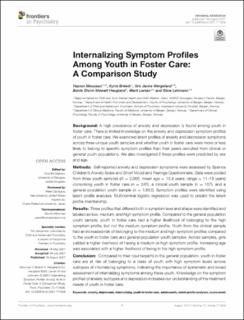| dc.contributor.author | Moussavi, Yasmin | |
| dc.contributor.author | Breivik, Kyrre | |
| dc.contributor.author | Wergeland, Gro Janne Henningsen | |
| dc.contributor.author | Haugland, Bente Storm Mowatt | |
| dc.contributor.author | Larsen, Marit Hjellset | |
| dc.contributor.author | Lehmann, Stine | |
| dc.date.accessioned | 2021-08-17T13:39:17Z | |
| dc.date.available | 2021-08-17T13:39:17Z | |
| dc.date.created | 2021-08-16T11:07:37Z | |
| dc.date.issued | 2021 | |
| dc.identifier.issn | 1664-0640 | |
| dc.identifier.uri | https://hdl.handle.net/11250/2768945 | |
| dc.description.abstract | Background: A high prevalence of anxiety and depression is found among youth in foster care. There is limited knowledge on the anxiety and depression symptom profiles of youth in foster care. We examined latent profiles of anxiety and depression symptoms across three unique youth samples and whether youth in foster care were more or less likely to belong to specific symptom profiles than their peers recruited from clinical or general youth populations. We also investigated if these profiles were predicted by sex and age.
Methods: Self-reported anxiety and depression symptoms were assessed by Spence Children's Anxiety Scale and Short Mood and Feelings Questionnaire. Data were pooled from three youth samples (N = 2,005; mean age = 13.9 years, range = 11–18 years) comprising youth in foster care (n = 245), a clinical youth sample (n = 107), and a general population youth sample (n = 1,653). Symptom profiles were identified using latent profile analyses. Multinominal logistic regression was used to predict the latent profile membership.
Results: Three profiles that differed both in symptom level and shape were identified and labeled as low, medium, and high symptom profile. Compared to the general population youth sample, youth in foster care had a higher likelihood of belonging to the high symptom profile, but not the medium symptom profile. Youth from the clinical sample had an increased risk of belonging to the medium and high symptom profiles compared to the youth in foster care and general population youth samples. Across samples, girls yielded a higher likelihood of having a medium or high symptom profile. Increasing age was associated with a higher likelihood of being in the high symptom profile.
Conclusion: Compared to their counterparts in the general population, youth in foster care are at risk of belonging to a class of youth with high symptom levels across subtypes of internalizing symptoms, indicating the importance of systematic and broad assessment of internalizing symptoms among these youth. Knowledge on the symptom profiles of anxiety subtypes and depression increases our understanding of the treatment needs of youth in foster care. | en_US |
| dc.language.iso | eng | en_US |
| dc.publisher | Frontiers | en_US |
| dc.rights | Navngivelse 4.0 Internasjonal | * |
| dc.rights.uri | http://creativecommons.org/licenses/by/4.0/deed.no | * |
| dc.title | Internalizing Symptom Profiles Among Youth in Foster Care: A Comparison Study | en_US |
| dc.type | Journal article | en_US |
| dc.type | Peer reviewed | en_US |
| dc.description.version | publishedVersion | en_US |
| dc.rights.holder | Copyright 2021 The Authors | en_US |
| dc.source.articlenumber | 711626 | en_US |
| cristin.ispublished | true | |
| cristin.fulltext | original | |
| cristin.qualitycode | 1 | |
| dc.identifier.doi | 10.3389/fpsyt.2021.711626 | |
| dc.identifier.cristin | 1926221 | |
| dc.source.journal | Frontiers in Psychiatry | en_US |
| dc.identifier.citation | Frontiers in Psychiatry. 2021, 12, 711626 | en_US |
| dc.source.volume | 12 | en_US |

